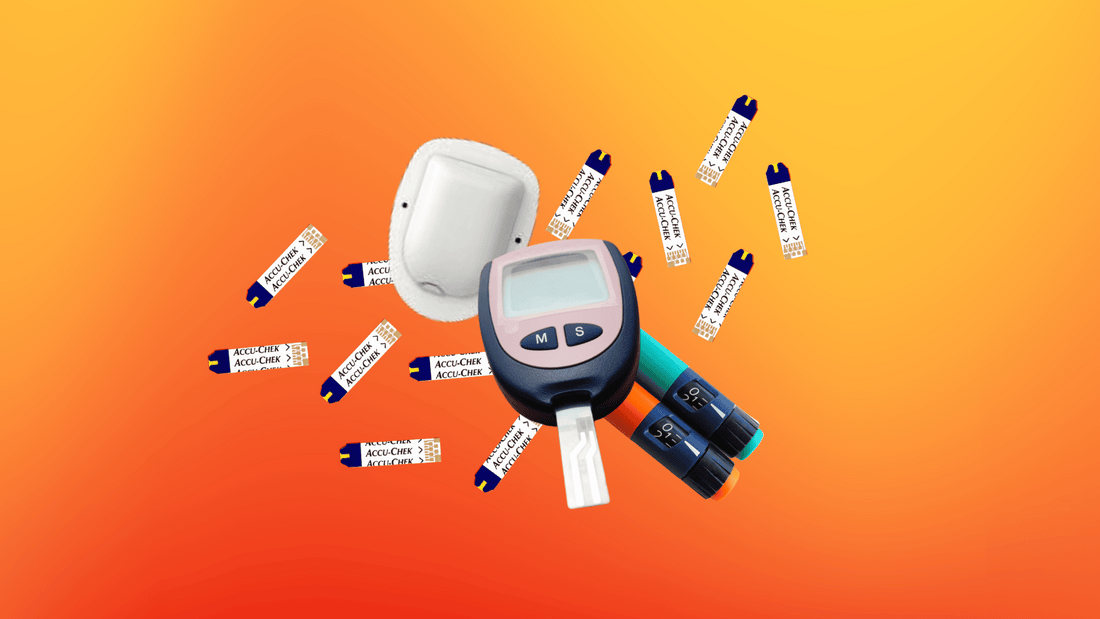
This blog post was written in partnership with Omnipod Australia.
Whether you’re a diabetes newbie (welcome!) or you’re an old hand at this, you might be interested to learn how other people monitor and manage their blood sugar levels. We asked our community for insights on why they choose the management tools they do.
Of course, only YOU can really decide what works for you. After all, your diabetes is YOUR diabetes. You don’t need to do it a certain way because that’s how you’ve always done it, or because that’s what someone has told you to do, or because some influencer who seems to have their sh*t together does it this way.
There’s no right or wrong way to manage diabetes. You do you. And in case no one’s told you lately – you’re doing great.
That said, let’s look at some different ways to manage Type 1 Diabetes, and what our community has to say.
*Quick note: We’re talking specifically about tech and tools in this article . But there are other management techniques you could consider as well, like intermittent fasting, low-carb diets, exercise routines and support systems (one person mentioned “hubby and kids reminding me of my meds” as a key management tool!).
1. Kitted out with tech: Insulin Pump + CGM
If you have the financial means (or the subsidy status!), you’re savvy with tech, and you want to take a load off your brain, you may choose to use an insulin pump and continuous glucose monitor (CGM). Some systems even integrate, so your CGM “talks” to your pump, and can suspend insulin delivery if a low-glucose event is predicted. Fancy!
Benefits:
- Might feel less invasive – One Dexcom x t:slim user said, “I was on MDI and finger pricks before… it was very life invading”. Using a pump and CGM can involve less manual handling and calculating. (In saying that… there are two devices connected to you at all times, so it depends how you define ‘invasive’.)
- May provide alerts – One person said, “The tech makes me aware of my highs/lows, which I don’t notice.” Many CGMs are fitted out with alarms to let you know if your blood glucose is high or low. This is a huge help for people who don’t feel hypos. CGMs also offer handy data to help you see patterns and make changes to your management if necessary.
- Less needles – While having things attached to you may freak you out, it means less finger pricks and injections overall. You only need to change your pump site every two or three days and refresh your CGM every seven to 14 days or so (depending on your device of choice).
Challenges:
- It’s expensive! – This is probably the biggest downside to this management combo. We received lots of comments like, “It’s so expensive to maintain.”
- Gadgets are attached to you 24/7 – It’s not for everyone, and that’s okay.
- Beep overload – One person said, “I like that I manage better. I don’t like the burnout from the beeps.” So perhaps it’s a trade-off. Alarms can be taxing, and even triggering, so regular breaks from all the tech may be a good way to avoid this sort of burnout.
2. Manual monitoring, automated insulin: Insulin Pump + Finger Pricks
Perhaps you love the idea of fewer needles but one device attached to you is enough, thank you very much. We didn’t come across too many people who manage their diabetes with the insulin pump/finger prick combination, but that doesn’t mean it’s not a valid way to do it! Too much tech can be overwhelming, and it could be a bit much to manage both. So if you’ve found a glucose monitor you love, hang onto that baby.
Benefits:
- Less things attached to you - If you’re an active person, or a young person, you may be disinterested in having too many bits attached to you. This setup gives you the automation of a pump and freedom of finger pricks.
- Less tech to manage – You may find that learning to use an insulin pump is enough work. CGMs provide excellent data, but if that’s overwhelming for you, manually finger pricking might be a better option.
Challenges:
- Staying motivated – Insulin pumps are great as long as you’re committed to using them correctly and staying vigilant with your blood sugar monitoring. It might help to keep track of your blood glucose recordings via an app or log book (find some cool ideas here), so you can spot trends and share them with your healthcare team.
- Adherence and skin sensitivity: Like all adhesive devices, some users may experience skin sensitivity to the adhesive used in infusion sets. Skin irritation or discomfort can occur, making it necessary to rotate infusion sites carefully and use additional adhesives or barrier products to mitigate any flare ups.
3. Embrace freedom and convenience: tubeless insulin pump
So you like the idea of an insulin pump, but your lifestyle (or sheer patience) isn’t compatible with endlessly tangling tubing?
The Omnipod Dash® System is a tubeless, simple, and discreet way to deliver insulin. Simply fill the Pod with insulin and wear directly on your body, delivering your insulin using the Omnipod DASH® Personal Diabetes Manager, or PDM, which is a smartphone-like device that communicates with the pod via secure Bluetooth. The Omnipod Dash System provides non-stop insulin delivery for up to 3 consecutive days, but with the added perk of zero tubes and not needing to be removed when showering or swimming.
Benefits:
- Won’t break the bank - With no 4-figure outright cost like most insulin pumps, Omnipod is more financially friendly. Dash Pods are also listed on the NDSS, meaning the cost of a tubeless insulin pump is subsidised for all T1D’s, and may even be completely covered if you also have private health insurance!
- Tubeless design: The Omnipod system eliminates the need for traditional tubing, providing freedom from a life controlled by door handles (if you know, you know).
- Wireless control: There’s no longer any need to exclusively buy dresses with pockets or get secret sections altered into your favourite ‘fit - the Omnipod's wireless, handheld PDM allows you to dose wherever, whenever (Shakira style).
Challenges:
- Insulin capacity: While the Omnipod has a 200-unit insulin reservoir, it may not be sufficient for users with higher insulin requirements. This can easily be managed with more frequent pod changes.
4. Great glucose data, manual insulin delivery: MDI* + CGM
(*Multiple daily injections)
If you’re comfortable with adjusting your insulin doses manually, this can be a great management combo! A CGM will deliver valuable data on how your blood glucose tracks over time so you can pick up on patterns to inform your dosage decisions. This may be a nice middle-ground for some, or a stepping stone from manual management to tech, without learning to use a pump and CGM all at once.
Benefits:
- You can spot patterns and adjust – CGMs are great for plotting out continuous glucose data over time, so you can see patterns and make adjustments as necessary. For example, you might notice your blood glucose spiking after lunch, prompting a discussion with your diabetes team on how best to manage it.indicating that an insulin to carb ratio increase is in order.
- You aren’t attached to a pump – MDI allows you to shower, exercise and have sex without having to worry about removing a pump or getting in an awkward tangle. This is a genuine decider for some people.
- MDI may put you in touch with your body – One MDI user said, “MDI gives you freedom… to learn control. Pumps take away a lot of skill”. Taking the time to calculate your doses and adjust your basal insulin certainly requires attention you might not normally give to your body.
Challenges:
- CGMs are more expensive – While CGMs are now subsidised for all people in Australia living with T1D, they can still be more expensive than the tried-and-true finger pricking.
- Injections can feel more invasive/obvious – One MDI x Libre user said, “I struggle with injecting at work.” Injections can feel more obvious than bolusing through a pump (“just give me a sec while I hitch my t-shirt up…”). That said, it’s not something you should be embarrassed about. In fact, it could be an interesting topic of conversation in the break room.
5. “Au Naturale”: MDI + Finger Pricks
This is how many of us start out our diabetes journey, testing blood sugars manually with a glucose monitor and test strips, and injecting insulin with pens. The key benefit here is that you don’t need to wear anything on your body. On the other hand, you may not like the lack of visibility over what your blood glucose is doing, or the effort of taking multiple injections a day.
Benefits:
- MOST cost-effective – One person noted that she’d prefer a CGM, but can’t justify the expense: “I trialled the Dexcom and loved it but it’s too expensive”. Glucose monitors are often more affordable.
- Easily accessible – You can find most products at your local pharmacy (or very soon order them via Stripped Supply!)
- Nothing is attached to you – You’re free as a bird. This might allow you to sleep more comfortably, exercise more freely, and maybe even forget you have diabetes sometimes.
Challenges:
- Requires lots of manual work – Without a CGM, you’ll need to extrapolate the limited data you get from your glucose monitor and make judgements based on that. It’s certainly not impossible, but some people find it more challenging.
- You need to take stuff everywhere – You’ll need a bag for this method, because you need to cart insulin pens, your glucose monitor, spare strips or cartridges and a bunch of other necessary crap around everywhere with you.
So what do you think? Are any of these benefits or challenges make-or-break for you? Let us know in the comments below. And remember, you’re not locked into any of these methods. Stay open to trying new methods and explore what you like best.
Please note that these insights and opinions are of a general nature and shouldn’t replace proper advice from your diabetes care team. Ask them lots of questions to help support you in making your decision.

